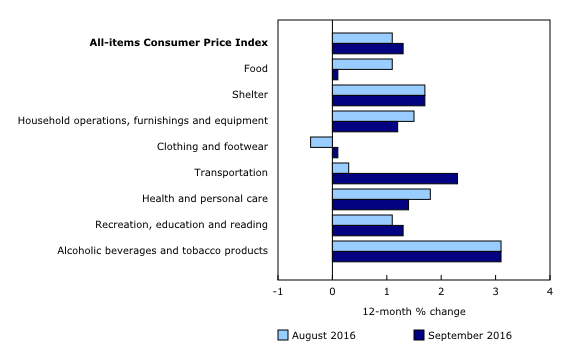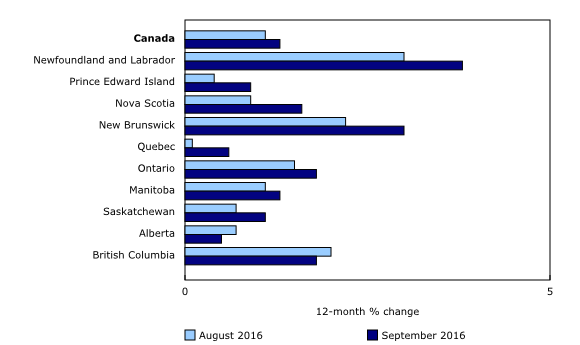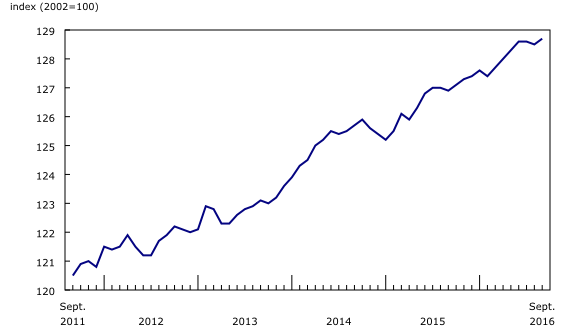Consumer Price Index, September 2016
Archived Content
Information identified as archived is provided for reference, research or recordkeeping purposes. It is not subject to the Government of Canada Web Standards and has not been altered or updated since it was archived. Please "contact us" to request a format other than those available.
Released: 2016-10-21
September 2016
1.3% 
(12-month change)
The Consumer Price Index (CPI) rose 1.3% on a year-over-year basis in September, following a 1.1% gain in August.
Excluding gasoline, the CPI was up 1.5% year over year in September, after posting a 1.7% increase in August.
12-month change in the major components
Prices were up in all eight major components in the 12 months to September, with the shelter and transportation indexes contributing the most to the year-over-year rise in the CPI. The food index posted its smallest year-over-year gain since February 2000.
The transportation index rose 2.3% in the 12 months to September, following a 0.3% gain in August. Gasoline prices posted a smaller year-over-year decrease in September (-3.2%) than in August (-11.5%). On a monthly basis, gasoline prices were up 0.8% in September, while they fell 7.9% in the same month in 2015. On a year-over-year basis, the purchase of passenger vehicles index increased 5.8% in September, after posting a 5.2% gain in August.
The clothing and footwear index rose 0.1% on a year-over-year basis in September, following a 0.4% decline in August. This turnaround was partly attributable to increases in the men's clothing index and the women's clothing index in the 12 months to September. Both indexes had declined in the previous month. For the fifth consecutive month, shoppers paid less for children's clothing on a year-over-year basis.
Food prices were up 0.1% year over year in September, after rising 1.1% in August. Prices for food purchased from stores recorded their first year-over-year decline since March 2008, down 0.9% in the 12 months to September. As a result of the decrease in September, food prices in stores returned to a level last recorded in January 2015.
Following gains in the price of some fresh vegetables in the fall and winter of 2015/2016, and subsequent monthly declines in those prices, the fresh vegetables index (-2.0%) in September was down year over year for the first time since January 2013. On a year-over-year basis, the price of cereal products (-4.9%), which include rice, pasta, flour and breakfast cereal, fell for a third consecutive month. The condiments, spices and vinegars index (-5.3%) and the dairy products index (-1.1%) were down year over year in September, following increases in August.
Prices for food purchased from restaurants were up 2.5% in the 12 months to September, matching the rise in August.
Tuition fees increased 2.8% on a year-over-year basis in September, matching the gain recorded in September 2015.
12-month change in the provinces
In eight provinces, consumer prices rose more on a year-over-year basis in September than in August. The exceptions were Alberta and British Columbia, where the CPI was up less year over year in September than in the previous month.
While the gasoline index was the main contributor to the acceleration in the 12-month change in consumer prices at the national level, its impact was greater in the Atlantic provinces. This acceleration in the year-over-year change in gasoline prices in Atlantic Canada partly reflected a disruption to a pipeline in the United States that services the region. Smaller year-over-year declines in the fuel oil index also had a greater effect on the acceleration in the 12-month change of the CPI in each of the Atlantic provinces than at the national level.
In British Columbia, the CPI was up 1.8% in the 12 months to September, after rising 2.0% in August. This deceleration was partly attributable to the price of food purchased from stores, which was down 1.6% year over year in September, after increasing 1.7% in August. The footwear index also recorded a turnaround, down 2.6% on a year-over-year basis in September, following a 5.9% increase in August.
In Alberta, the CPI increased 0.5% year over year in September, following a 0.7% gain in August. This deceleration was led by the price of food purchased from stores, which declined 2.2% year over year in September, after increasing 1.8% in August. The natural gas index also contributed to the deceleration in the 12-month change of the provincial CPI, as prices were down 4.5% year over year in September, following an increase of 2.8% in August. At the same time, on a year-over-year basis, the traveller accommodation index declined less in September than in August.
Seasonally adjusted monthly Consumer Price Index increases
On a seasonally adjusted monthly basis, the CPI increased 0.2% in September, after declining 0.1% in August.
In September, four major components increased on a seasonally adjusted monthly basis, while three declined. The shelter index was unchanged.
On a seasonally adjusted monthly basis, the recreation, education and reading index (+0.4%) recorded the largest gain in September, while the food index (-0.4%) posted the largest decline.
Bank of Canada's core index
The Bank of Canada's core index increased 1.8% year over year in September, matching the gain in August.
The seasonally adjusted core index rose 0.1% on a monthly basis in September, after being unchanged in August.
Note to readers
A seasonally adjusted series is one from which seasonal movements have been eliminated. Users employing Consumer Price Index (CPI) data for indexation purposes are advised to use the unadjusted indexes. For more information on seasonal adjustment, see Seasonally adjusted data – Frequently asked questions.
The Bank of Canada's core index excludes eight of the CPI's most volatile components (fruit, fruit preparations and nuts; vegetables and vegetable preparations; mortgage interest cost; natural gas; fuel oil and other fuels; gasoline; inter-city transportation; and tobacco products and smokers' supplies) as well as the effects of changes in indirect taxes on the remaining components.
Next release
The CPI for October will be released on November 18.
Products
The September 2016 issue of The Consumer Price Index, vol. 95, no. 9 (62-001-X), is now available from the Browse by key resource module of our website, under Publications.
More information about the concepts and use of the Consumer Price Index (CPI) is available in The Canadian Consumer Price Index Reference Paper (62-553-X).
For information on the history of the CPI in Canada, consult the publication Exploring the First Century of Canada's Consumer Price Index (62-604-X).
Two videos, "An Overview of Canada's Consumer Price Index (CPI)" and "The Consumer Price Index and Your Experience of Price Change," are available on Statistics Canada's YouTube channel.
Contact information
For more information, or to enquire about the concepts, methods or data quality of this release, contact us (toll-free 1-800-263-1136; 514-283-8300; STATCAN.infostats-infostats.STATCAN@canada.ca) or Media Relations (613-951-4636; STATCAN.mediahotline-ligneinfomedias.STATCAN@canada.ca).
- Date modified:





